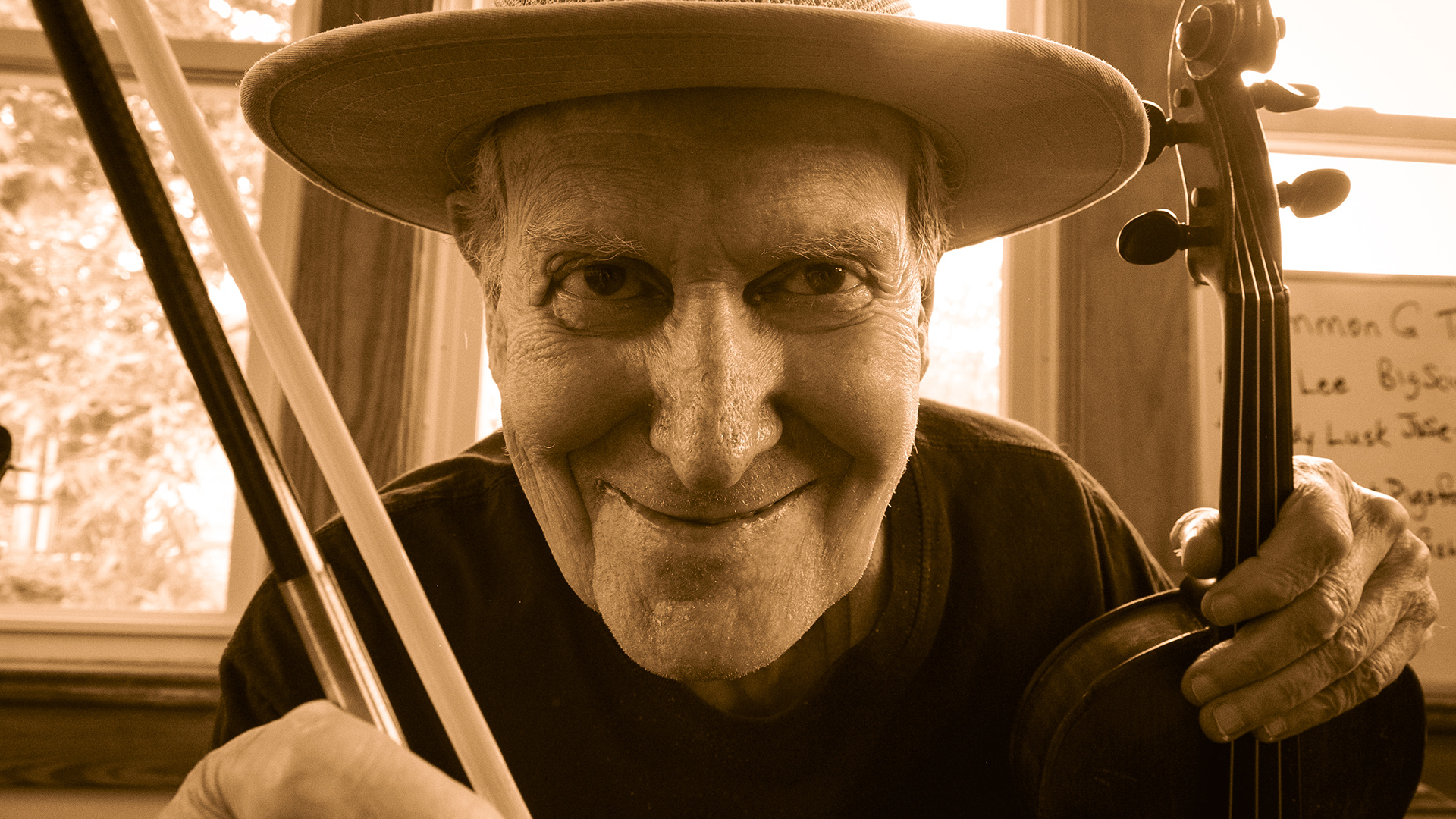
On the Rails of the Mystery Train
He’s almost 90, and he teaches music in a little school in Georgia. He’s also an unsung giant of American folk music who played with Woody Guthrie and Pete Seeger. Meet Frank Hamilton.
It was a marvelous life the two of them had. Then she died.
Imagine thirty wonderful years on Cinderella Court in Decatur, Georgia, with the love of your life, playing music together and being with marvelous friends. Imagine the fun of being on a seesaw, then one day when you’re up, smiling at her across the seesaw, she vanishes.
Whump, you hit the ground.
Frank Hamilton was eighty when his third wife, Mary Smith, died of a heart aneurysm one Monday in December at home, with him there. She had been the very picture of health, a lovely, lively redhead who was always preparing healthy food and organic teas for Frank and their friends. Suddenly, he was living alone on Cinderella Court, crying, sinking into the abyss. After her death, he was seeing a therapist, as always, but he was ready to jump out a high window somewhere.
Frank Hamilton, a legend of America’s Folk Music Revival in the 1950s, was on the verge of taking himself out.
Frank turned eighty-nine years old this week, and you can find him teaching classes in a variety of American musical styles at the Frank Hamilton School of Music, tucked away in a little brick building in a former Confederate orphanage in Decatur’s 77-acre Legacy Park.
A typical night. Five older men, average age about 50, and one teenager, hair in his eyes, are in Frank’s Swing Guitar class. Frank in a wide-brim hat plays his classic Gibson ES 345 semi-hollow “eclectic” guitar. He leads them through slow, cool jams. “Tuxedo Junction,” “There Will Never Be Another You,” “Jersey Bounce,” “How High the Moon,” “Cherokee.”
As class winds down, an old friend enters, bringing a huge fresh energy into the classroom that will hold the students enthralled for another hour. A typical night, they are all “staying after school,” says another teacher who has come in, Mick Kinney, and everybody laughs. “Hang out, Mick,” Frank had told him.
“After school” can mean a jam, or just great talk about American musical history and musicians they know, or once knew. Frank Hamilton has known many. They were his friends: Woody Guthrie, Pete Seeger, Bob Gibson, Tommy Makem, Odetta, Don McLean. And now there’s John McCutcheon and a bunch of other cats around Atlanta.
“Man, this guy’s read half the books ever written. He’d talk about this, he’d talk about that.”
The cool old friend who entered the room is Tom Woods, a symphony percussionist, jazz pianist, and composer who has a studio and performance space in his home on Lake Lanier. He has driven a long way tonight to see Frank again for the first time in years. Tom holds the class spellbound with stories about Frank—stories Frank is too self-effacing to tell about himself.
This guy, says Tom Woods, helped start that music school in Chicago. Tom is mixed up about the name of the school. Frank politely fills in the blanks of Tom’s frisky storytelling—it’s the Old Town School of Folk Music that Frank helped launch in 1957 and is still going strong, with some 6,000 students, strong enough that some of its current teachers helped start the Frank Hamilton School of Music in Decatur in the fall of 2015.
Tom’s story about meeting Frank a few years earlier is meant to let these students know how “unbelievable” Frank is. Tom and a girlfriend met Frank and Mary at a few gatherings of the Atlanta Atheists at The Thinking Man’s Tavern in Decatur. Talking across the table, Tom was amazed at this other man’s knowledge.
“Man, this guy’s read half the books ever written,” Tom says. “He’d talk about this, he’d talk about that.”
Indeed, Tom and Frank went on and on about Prokofiev’s Romeo and Juliet, Ravel’s “Piano Concerto for the Left Hand,” John Coltrane’s “Giant Steps,” Billy Strayhorn’s “Lush Life,” Dolly Parton as a genius, and what was that philosopher’s name, Wittgenstein? Heidegger? Yeah, that’s it.
The punch line of Tom’s story is that he was friends with Frank Hamilton for a month or two at the Atlanta Atheists group (“I’m not anti-theist,” Frank explains later) before he learned Frank was also a musician.
The next morning, Frank is back in the same window-lined classroom, Oriental rugs baffling the acoustics. He’s filling in for another teacher in the “Intro to Jam Sessions” class. Today, it’s Klezmer day, for the traditional Yiddish folk music. Frank is “scraping along” on a fiddle as he leads the six students through “Die Griene Kuzina” and “Tumbalalaika.”
He recites some of the Yiddish verses from memory, with a remarkably fine Yiddish-German accent he’s learned by ear, not study. What comes across, as he plays his fiddle, is that Frank Hamilton, of Los Angeles, New York, Chicago, and now Georgia, seems to share the deep lamentation of the songs, a unique form of human sorrow that only Yiddish Klezmer can express.
At the end of “Tumbalalaika,” in a pose of Hasidic frenzy, this grief-touched Protestant-Atheist throws up his gangly arms, a bow in one hand and a fiddle in the other, a faint smile on his moon face.
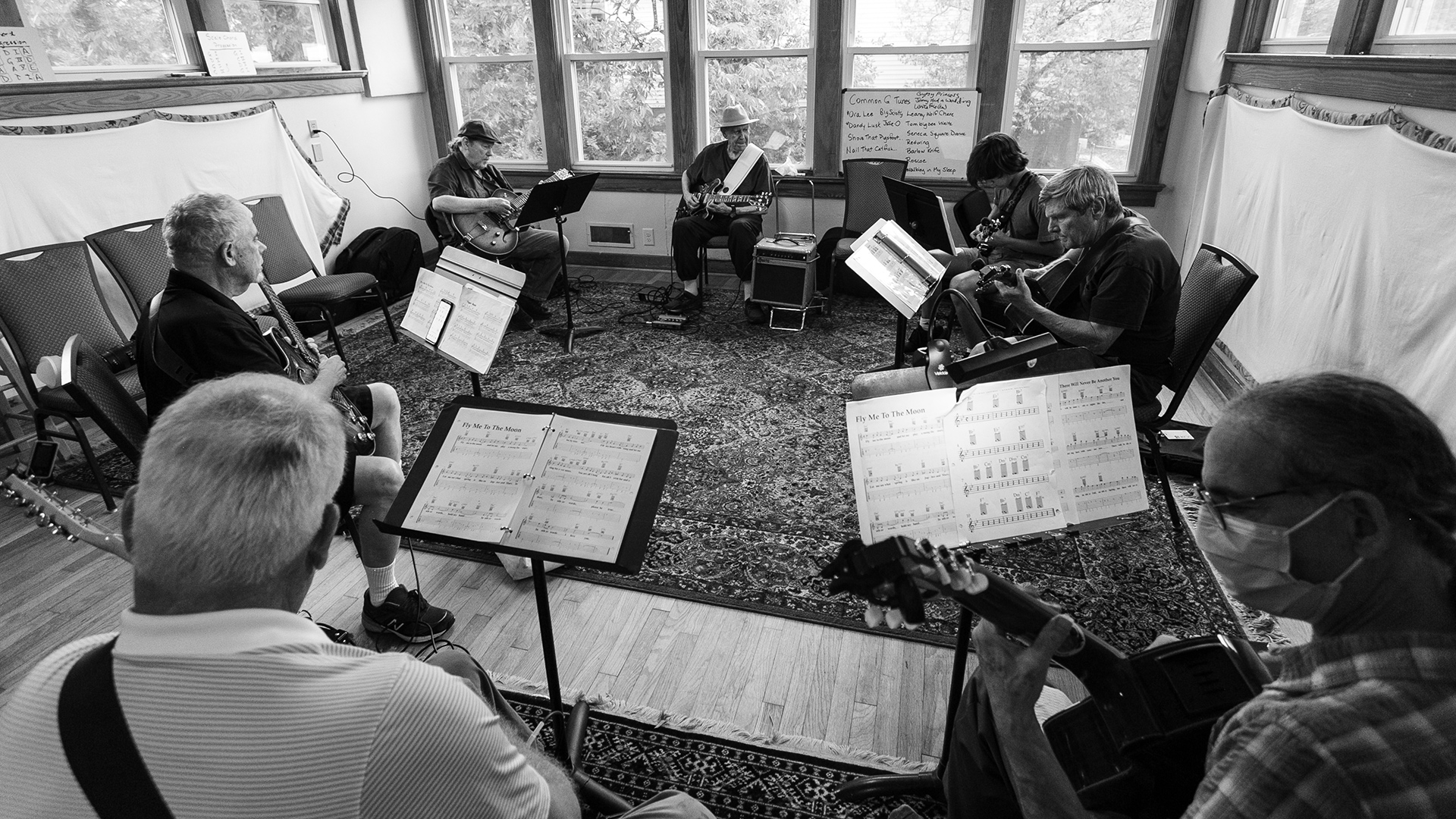
In Lubbock, Texas Tech University’s Special Collections Library acquired, after a semi-famous five-string banjo player’s death in 2016, a rare twelve issues of a magazine called Caravan. In 1957 and ’58, Caravan was a hand-typed and mimeographed magazine of the cultish Folk Music Revival, costing 35 cents but distributed for free around Izzy Young's Folklore Center, 110 MacDougal Street, New York City, and at the Sunday afternoon picking sessions around Greenwich Village’s Washington Square Park.
The October-November 1958 issue features Frank Hamilton in two articles and a cover photograph, smiling, cradling a guitar, chin in a hand, looking like “a slightly disheveled basketball player,” as one article describes him.
“At first he seems distant, reserved, difficult, but the moment something real happens—a song, a remark, anything—Frank responds with a directness and an openness almost frightening,” wrote Mark Morris in the first of these two articles, labelled “An Impression.” The writer ends with a quote from Frank that shows an ambition for concert performing, and finding or forming a good band. But in the quote, there hovers a restless uncertainty.
“For now,” Frank told the writer, “I’ll go on teaching at the Old Town school until it can stand on its own two feet and I can take off.”
The other article, “An Appreciation,” was by Erik Darling, the singer-songwriter banjo and guitar picker who would replace Pete Seeger in The Weavers in 1962 (before Frank replaced Darling, leading to both joining the legendary Weavers’ 15th Anniversary Reunion concerts one weekend in May 1963 in Carnegie Hall).
“Frank’s high regard for the value of ‘delving deeply into the traditional roots of all kinds of music’ makes even the most wild of his arrangements more true to the traditional aspects of a particular song than most of our so-called purists.”
“Frank’s high regard for the value of ‘delving deeply into the traditional roots of all kinds of music’ makes even the most wild of his arrangements more true to the traditional aspects of a particular song than most of our so-called purists,” Darling wrote, “and at the same time, gives his material a freshness and life so necessary for folk music.” He ends the article with a vague premonition that Frank Hamilton would carry an important mission into the future. “Good luck to you, Frank Hamilton….”
His life by 1958 seemed lyrically wrought in the American folk music tradition. Before Dylan and other ’60s folk-rock stars, he was the youngest, at 24, and most dedicated follower of the rambling politically active folk music lifestyle. Before he was 20, he was hanging out and playing music with Woody Guthrie and Pete Seeger at the Topanga Canyon ranch of leftist actor Will Geer, who had been exiled there in California by the Joe McCarthy witch hunts.
Frank was born on August 3, 1934, in New York City, his father already dead, a father he admired as a “philosophical hobo” who hopped freight trains. Growing up in Los Angeles with a piano-teacher mother and Merchant Marine stepfather, Frank took Woody Guthrie’s autobiography, Bound for Glory, as his guide. He taught himself banjo in rail-drumming boxcars and fell in with Guthrie and Seeger as a musical prodigy.
But there was something in Frank’s restlessness that was unique. He was listening to jazz and what was then called “Negro blues.” He played all kinds of instruments, and was never quite satisfied by any genre—or by his proximity to stardom.
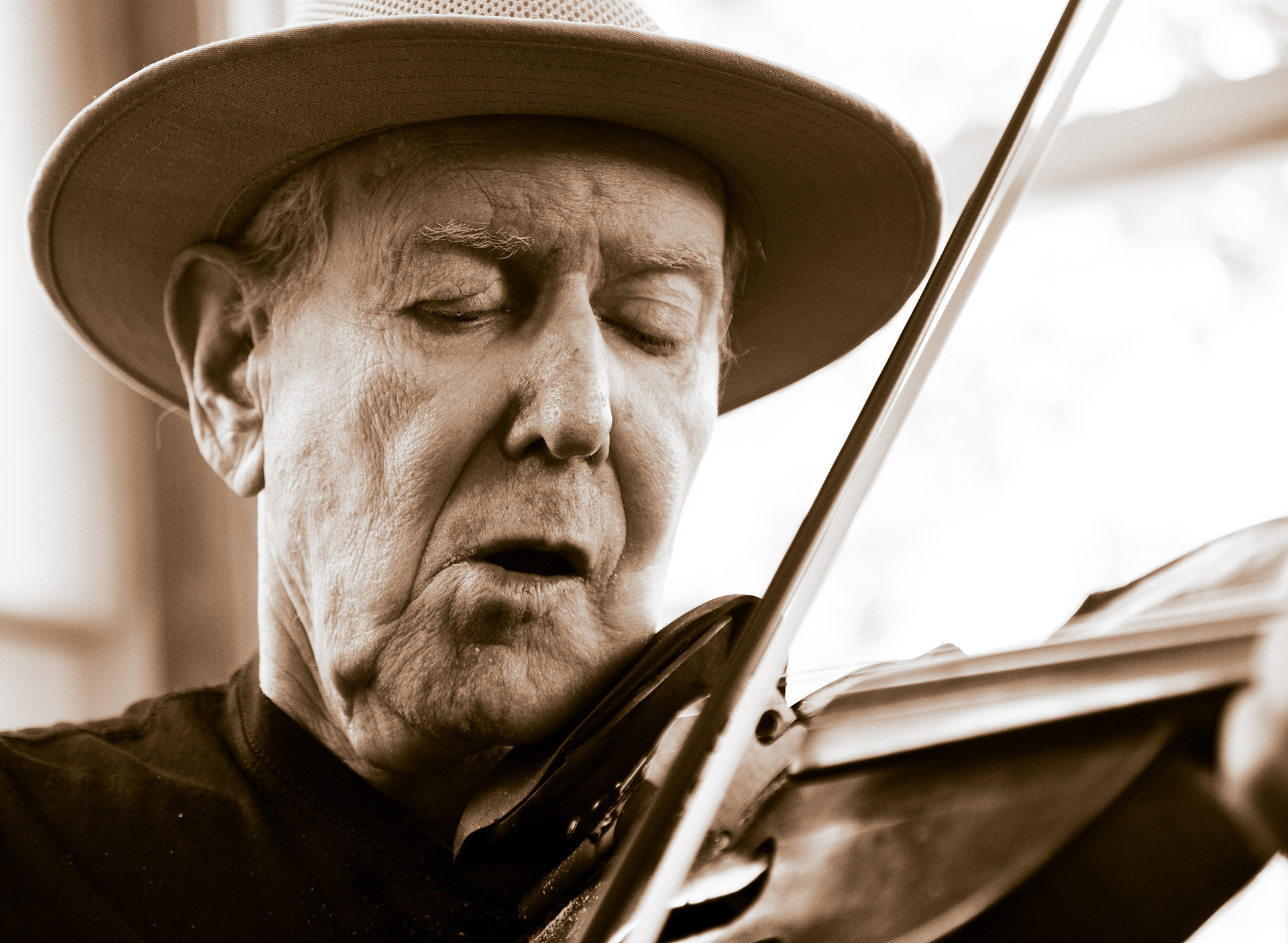
If you’re into the music of das volk, the working man, the oppressed, you do what John A. Lomax and his son Alan did during the Great Depression. You travel the dusty back roads of the poor South, looking for songs. Frank had been planning this trip with his older folk music buddy Guy Carawan for some time. In 1953, in Los Angeles, Frank put a toothbrush and pajamas in his guitar case and hitchhiked Route 66 eastward, New York-bound to meet Guy and head South.
He made it to Pete Seeger’s home in Dutchess Junction, overlooking the Hudson. A good place to start, since Pete’s parents, musicologists Charles and Ruth Seeger, had, like the Lomaxes, combed the South for folk music. Frank shared a tent in the yard with another folky, a bluegrass banjo picker whose daddy was the Hollywood director King Vidor. Frank, amid the banjo plucking, had a severe allergy attack, knocked on the Seegers’ door, and was taken to the local hospital by Pete’s wife Toshi. Oh, the things you remember! The friends you had!
The next morning, he made it to Greenwich Village to meet Guy Carawan and the man who introduced the 12-string guitar to folk music, Fred Gerlach. (Gerlach later wrote “Gallows Pole,” which Led Zeppelin covered.) Frank, Guy, and Fred had to share a bed that night in a dive near the rumble of the “L.” The next morning Frank and Guy took their guitars to Washington Square, Ground Zero of this happening revival, when a hulking cowboy of a figure known as Ramblin' Jack Elliott joined their picking and talking.
Frank and Guy said they were heading South for the music, and Ramblin’ Jack asked if he could go with them. Why not?
“That turned out to be a good move,” Frank says, retelling the story at an open-air lunch in Decatur. “Jack was a catalyst for us, because he could talk to people.” Jack had the gift of gab, an endless source of storytelling, of “rambling,” with an additional talent for impersonation. It helped them get out of trouble, which a couple of naïve white Northern lads could get into in the South of that time.
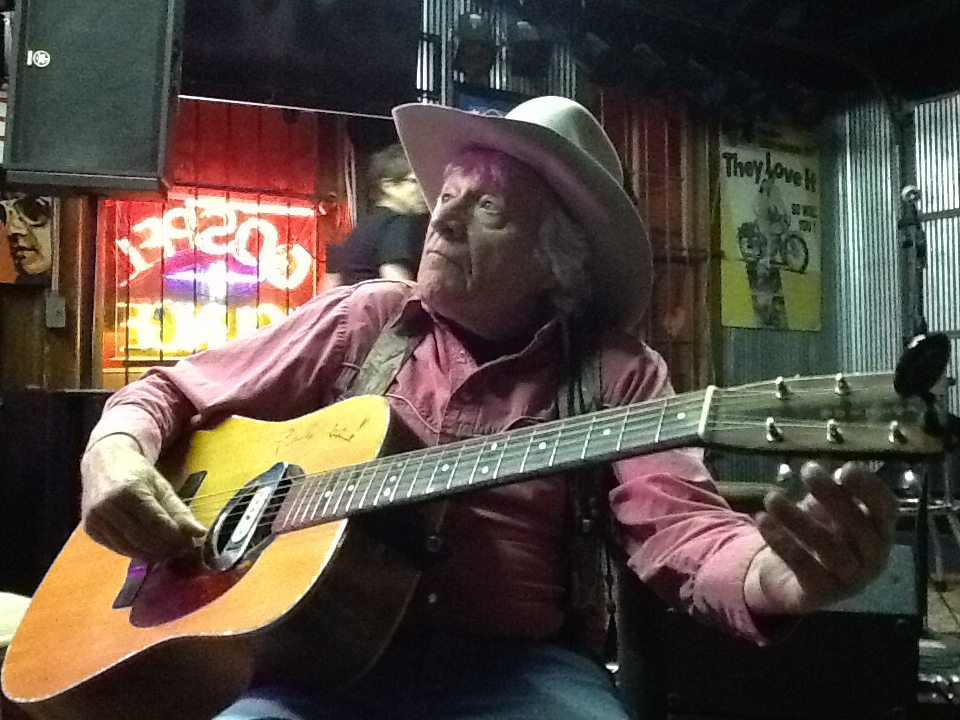
“That turned out to be a good move. Ramblin' Jack Elliott was a catalyst for us, because he could talk to people.”
They stayed with Guy’s Uncle Claude, a shrimper in Virginia, who told them if they went to the Black church for “Negro music,” they’d better get out of town fast. They started busking, needing gas money, and the sheriff in Newport News ran them off for competing with the Salvation Army band. They went to Merry Point, Virginia, looking for a Black poet, but found they had been framed by the local Klan and sheriff for torching a building in a labor war with the local Menhaden fishermen.
They also spent a lot of time hearing and learning the music of the Appalachian mountains in North Carolina and Tennessee, meeting legends like A.P. Carter of the Carter Family, and were welcomed into many friendly white homes. And, of course, they made it down to New Orleans.
It was in the summertime
I went down there with Frank and Guy
We sang and busked our way through the Smoky Mountains
And on down to New Orleans.
—from Ramblin’ Jack Elliott’s “912 Greens”
Ramblin’ Jack Elliott, who is still alive at 91, went on to record some forty albums and was a founding member of Dylan’s 1975 Rolling Thunder Revue tour. Guy Carawan went back South as the Civil Rights Movement gathered steam and in 1959 became music director at the progressive Highlander Folk School in Monteagle, Tennessee. Zilphia Horton, the previous music director, had learned an old gospel song that tobacco labor organizers had picked up as “We Shall Overcome.” The Rev. Martin Luther King Jr. heard and learned it when he visited Highlander Folk School in 1957. The version that the Student Nonviolent Coordinating Committee learned from Guy Carawan at its founding meeting in 1960 was copyrighted by Pete Seeger, Zilphia Horton, Guy Carawan and Frank Hamilton.
Meanwhile, three years after that vagabond jaunt across the South, Frank was in Chicago. Once again, he was at the very heart of a Folk Music Revival community, this one in a downtown neighborhood known as “Old Town.”
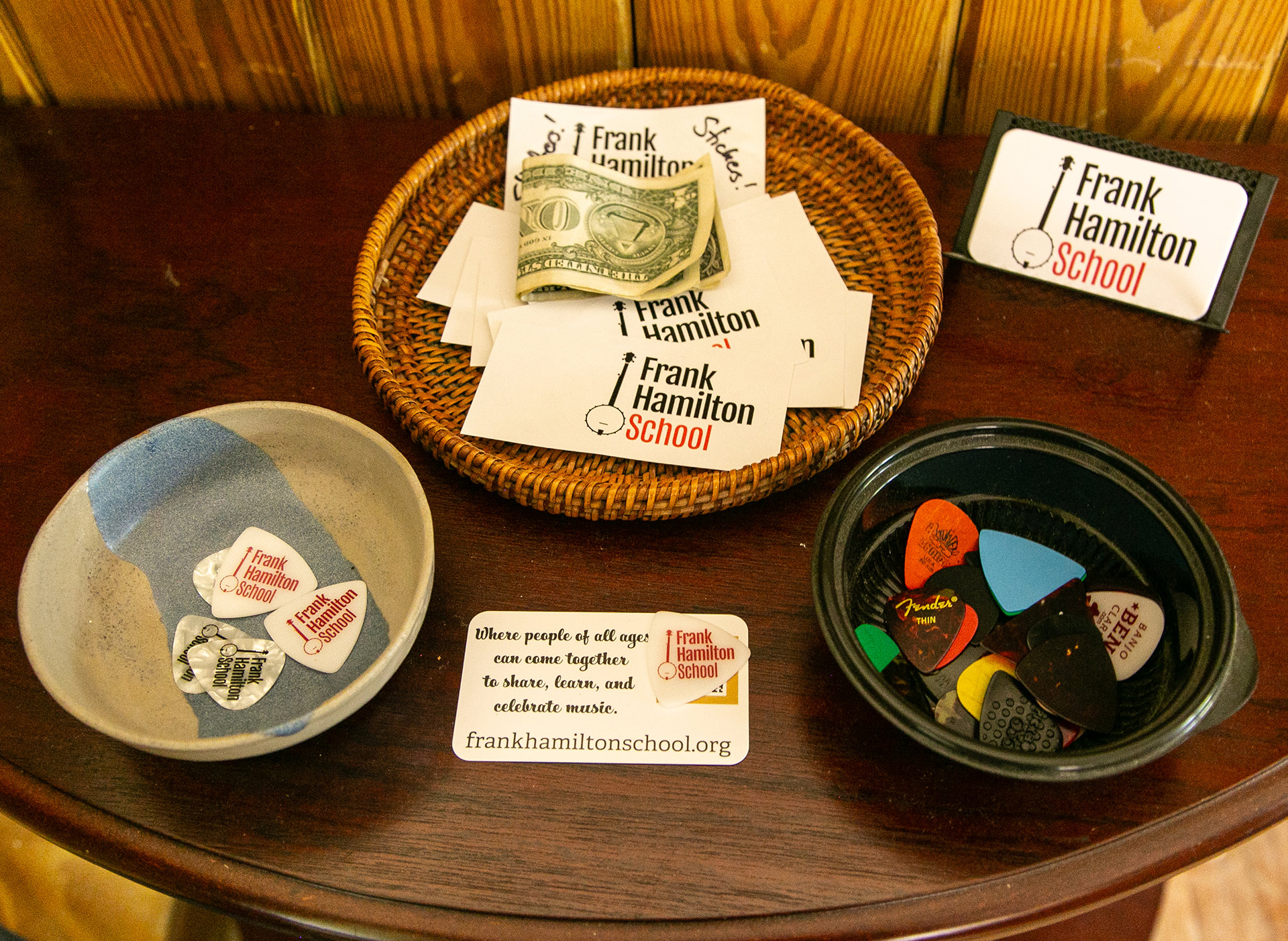
In 1957, Bob Gibson, another Folk Music Revival legend who had just won a talent spot on the Arthur Godfrey Show, brought Frank from Greenwich Village to Chicago to play at The Gate of Horn. This was one of the first folk clubs in the country, crammed into the basement of a hotel in Old Town. A young Joan Baez and The Byrds’ Roger McGuinn would get their start there. Bob Gibson was the usual emcee.
Frank Hamilton’s solo performance at The Gate of Horn so charmed a woman in the audience that she asked if he would teach a class in folk music in her living room. Sure, why not?
Word got out, and Frank turned out to be an outstanding teacher. He knew the full repertoire of folk songs and could break them down—the chords, melodies, and lyrics—in ways that were fresh and real, not music theory and not academic jargon.
A week or two into this, a man attending the crowded living room lessons said aloud that he was going to start a folk music school for this sort of teaching. That was “Uncle Win” Stracke, as he was known on his children’s TV show until it was blacklisted for Stracke’s suspected communist leanings. Stracke did, in fact, start a school. The Chicago arts community was so active then the Old Town School of Folk Music was an immense success from its opening day in December.
Frank Hamilton was one of the first and most popular teachers, because he could teach any level of guitar. Sometimes he would rotate around three classes, teaching the same song on three levels simultaneously. For the beginner class, basic strumming. For the intermediate class, barre chords. And then there was the advanced class.
“I think it was really hard for her to take the life of a musician. It’s really difficult, because first of all, we never make much money, and it’s a very time-consuming kind of a thing. It’s all absorbing, and you live that life.”
Roger McGuinn thought he knew how to play guitar, but Frank showed him so much more at the Old Town School—the chord cycle of fourths, the blues and other advanced-level skills. This was all before McGuinn and his Byrds hit No. 1 on the charts with his Rickenbacker 12-string, tinted granny glasses and lead singing on Pete Seeger’s “Turn, Turn, Turn (To Every Thing There Is a Season)” and Dylan’s “Mr. Tambourine Man.”
The Old Town School outgrew its first building and performance space on North Avenue, taking on thousands of students, old and young, and occupying two other buildings over time.
It became Frank’s second home as he moved restlessly through a variable career as a musician. For over two decades, based in Chicago, then Los Angeles, Frank made his living as a performer, songwriter, studio musician, and teacher. He co-wrote several hit songs with Ernie Sheldon, including “And We Were Strangers,” sung by Patty Duke, and the soul song “Baby What I Mean,” covered by the Drifters in 1966.
Home and family varied, too. His first wife, Sheila, was an African-American woman he met in Chicago. They had four children, two surviving (including a married son who lives in Carrollton, Georgia, close enough to jam on jazz guitar with Frank occasionally). He and Sheila grew estranged and divorced. His second wife, Deanne, he divorced “amicably” after ten years.
“I think it was really hard for her to take the life of a musician,” he says now. “It’s really difficult, because first of all, we never make much money, and it’s a very time-consuming kind of a thing. It’s all absorbing, and you live that life, you know. It’s a lifestyle, really.”
The next romantic relationship was in New York with an old girlfriend who used to be with him in the Washington Square folk-singing circles twenty-five years earlier. She moved to Boston, he followed, and the relationship ended there.
Then, in Boston, he met the love of his life, Mary Susan Doyle Smith, a reservation sales manager for Delta Airlines. They married in 1983, and decided to move to Atlanta to escape Boston winters. Mary made a collateral career move to Delta’s corporate hometown.
For the next thirty years, it was a marvelous life they had together.
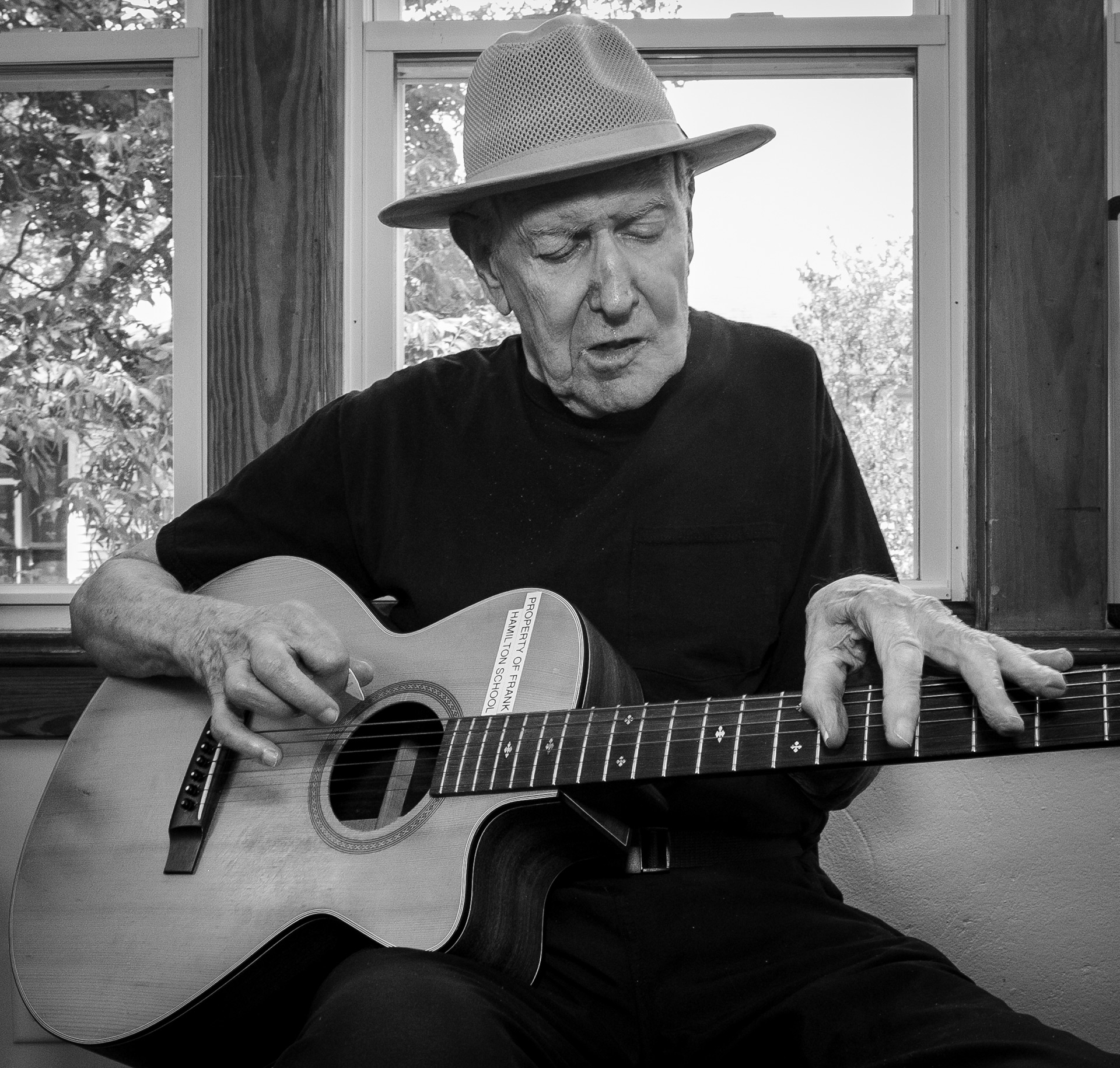
Mary’s job at Delta eased the first problem of a musician’s life, the money problem. They did not live the troubadour’s all-consuming lifestyle. Life with Mary around Atlanta became a lot more relaxed. They played and sang together at parties, with friends, at The Freight Room, a club in Decatur’s old train station, and at retirement homes.
It seemed like the happily-ever-after life on Cinderella Court, especially after Mary retired. They ran a little business that brought their music to young audiences in the metro Atlanta schools and to older folks in retirement homes.
The glory of it was the people who heard them. So many merry faces in classrooms. And so many interesting people in the retirement homes, people who in their past lives were as fabulous as Frank Hamilton, but now forgotten. Frank and Mary met a former shortstop for the St. Louis Cardinals. They met an aunt of George and Ira Gershwin.
In Marietta, they met a former basso profundo of opera, an Italian native named Cesare Siepi, who heard Frank sing “O Solo Mio” for him. According to Wikipedia, Cesare Siepi was one of the finest bass singers in opera after World War II, brought to the Metropolitan Opera in 1950 by Sir Rudolph Bing. Who knows how he ended up in a retirement home in Marietta and died in an Atlanta hospital in 2010?
Frank and Mary touched many lives with their music and their kindness, a kindness that they extended to all equally.
Frank’s philosophy of music was like his philosophy of life. It was socially based, connecting people and building community. And it was always dissenting, a rebellion from any orthodoxy or convention that might enslave his integrity. He dissented, finally, even from his worship of the noble vagabond, the image he idolized in Woody and Pete, “free from social restraints, picking up and going where it suited me.” He broke free, even, of that “freedom.”
In a recent hour-long documentary aired on public television, Frank Hamilton and the Folk Revival, he says this idolized archetype may have deterred him from a path that was more realistic—and more rewarding.
The right path wasn’t just teaching. He occasionally burned out on teaching. And it wasn’t just playing music with others. Although both teaching and playing were a part of this “more realistic and rewarding path,” there was something deeper at the heart of it. He was close to the heart of it with Mary.
And then she died.
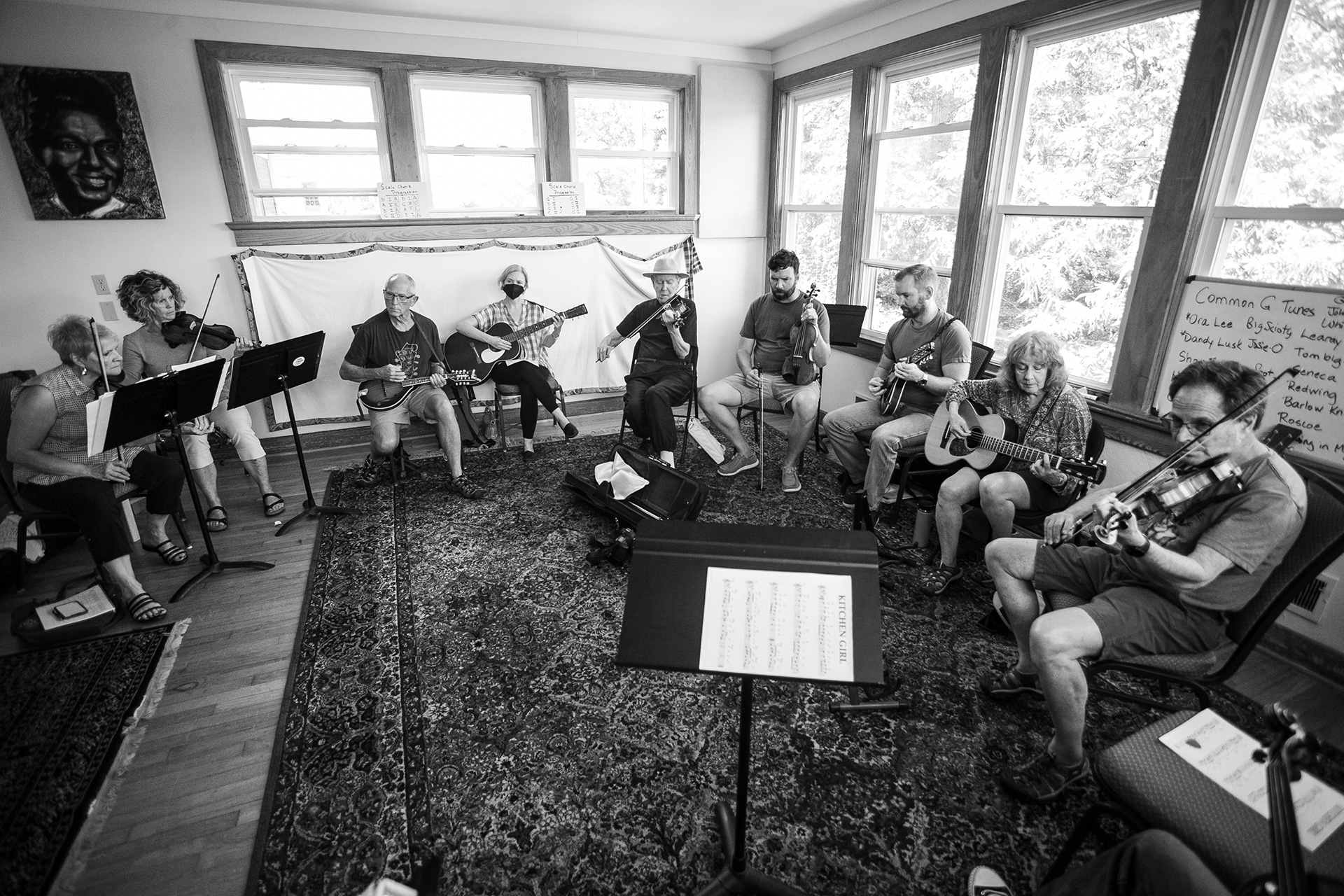
The memorial service for Mary on March 29, 2015, packed a popular venue in Sandy Springs, Steve’s Live Music. For friends of Frank and Mary, the shock of her death had settled down into an outpouring of love and emotion.
But when Frank finally arrived, he looked defeated, so haggard it shocked Bob Bakert, the emcee. Bakert had not seen Frank in a while. They had met years ago when Bakert booked him at The Hungry Ear Coffee House in Sandy Springs. He began attending the weekly jam sessions at Frank and Mary’s house on Cinderella Court.
At the memorial service, from Bob’s perspective, Frank looked like a man wobbling on the precipice, ready to die.
“When I was off the stage, Frank was in the corner by himself,” Bakert recalls. He approached and began vamping with small talk. Then he got to the point. “I said, ‘Frank, you know you don’t look so good. We’ve got to get you out of this. You can’t let this be the end of you.’” The way you might talk a man off a bridge railing, Bakert went through a list of interests that might bring Frank back into life. Can we go for a hike? Go fishing?
“I said, ‘Frank, you know you don’t look so good. We’ve got to get you out of this. You can’t let this be the end of you.’”
Frank’s words were those of a man with a big pain and little hope. He mentioned that some there wanted to start a music school, and he mentioned the Old Town school in Chicago. All of this was new to Bakert, a professional guitar player-turned-entrepreneur. But Frank seemed a bit more animated now.
Bakert saw his chance.
He got in Frank’s face, eyeball to eyeball. Bakert felt some higher power driving him. A life was at stake. He remembers what was said.
“Frank, we’re going to start a school.”
Frank stared at him like he was from Mars, so Bakert continued. “You don’t know me very well, but if I tell you I’m going to do something, I’m going to do something. Listen to me! Look at me!”
“Well, okay,” Frank managed to say, taken aback.
“Obviously we can’t do anything right now, but I’m going to call you. Look at me. I promise you, we are going to start a school like the Old Town School in Chicago.”
Bob Bakert didn’t know what the hell he was getting himself into. All he knew was that this guy had seemed dead, and now he was alive. A few days later, after Bakert had talked business with the Old Town School, he called Frank. Frank was back in the game. He answered the phone in his old chipper way, “Hi, Bob.”
Soon after that, Bakert and a business friend in Atlanta, a Coca-Cola global vice president who had been a student at the Old Town School, met Frank in Chicago. They discovered that Frank Hamilton, to the Old Town School of Folk Music, was a god. People herded out of classrooms to see him like he was one of the Beatles, or the Pope. Getting to see him took time, because he spoke to each person as an equal, a fellow musician, and a worthwhile human being.
Over the next few months, the combination of Bakert’s business sense (and connections) and Frank’s vision of a music school for regular folks created The Frank Hamilton School of Music, a nonprofit with a board of directors and a faculty that included Frank. It began holding classes in late 2015 in a church in the Inman Park neighborhood of Atlanta, then moved to Oakhurst Baptist Church in Decatur, then to the new Legacy Park that the City of Decatur had recently bought from the old United Methodist Church Children’s Home.
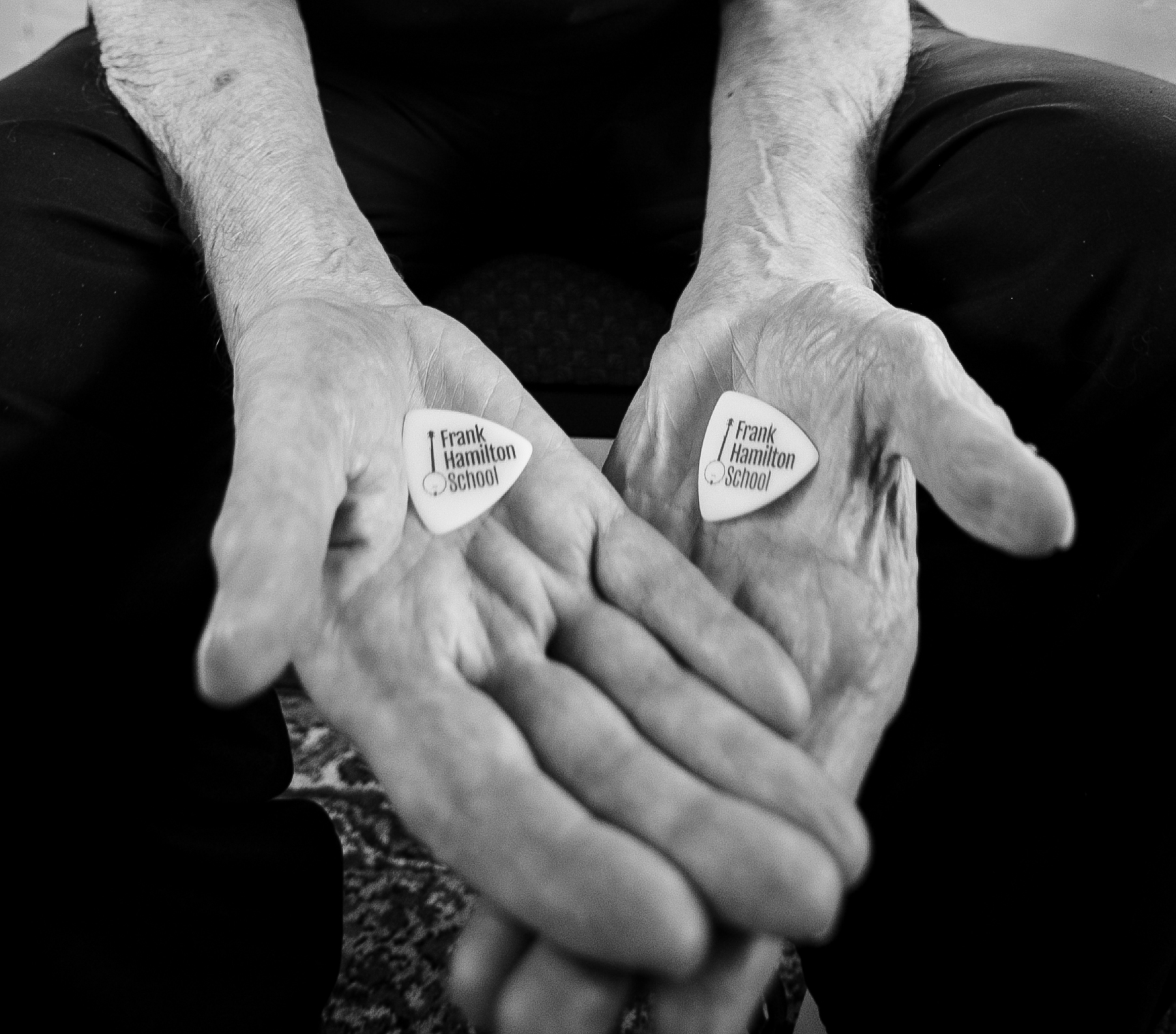
These days, in its current building, which was empty during much of the pandemic, the lights stay on well into the night. Classes stretch into jam sessions, or discussions like the one Frank and Mick Kinney are having with their visitor, jazz pianist Tom Woods.
Frank’s ride home—he stopped driving because of age—will need to notify Christie if this goes too long. Christie Schauers, his wife, keeps an eye on Frank’s well-being from where they live in a townhouse about ten minutes away.
Tom has another mission, besides visiting his old friend. He wants to see how he might partner with the school by offering his gorgeous home studio and performance space on expansive property next to Lake Lanier. He sits at the upright piano and plays an intense, Latin-sounding composition he’s working on, complimenting Frank on how well tuned the piano sounds. He encourages Frank to come out to his place to perform.
Frank demurs, saying he lost the higher range of his singing voice to radiation (which successfully cleared his melanoma, he reveals later). But he says he will come out and visit. He wants Tom to hear some melodies and lyrics he’s been working on. And he says he’s thinking about starting a school or branch of this one, specializing in jazz.
“Well, you see now, here’s the deal. Everybody who walks in the door is automatically a musician. We may be at different levels, but we’re all musicians.”
The school will grow organically, but not with marketing or professional PR, because that’s not Frank Hamilton’s style. It’s more like a very large and loose family. Even a journalist visiting to write a story is treated like a family member. Here, he’s told, grab that guitar.
Or rather, it’s a Third Space, the theory of community that Frank and Bob Bakert had in mind from the start. The First Space is the family. The Second is school. And the Third is church. But as human-scale neighborhood churches vanish from habits of the heart, the Frank Hamilton School fills the vacuum. Music is the faith part, a unifying human invention.
“What a cool place, Frank,” Tom says. “And you just surround yourself with cool people.”
“Well, you see now, here’s the deal,” Frank says. “Everybody who walks in the door is automatically a musician. We may be at different levels, but we’re all musicians. It doesn’t matter. Because as long as you have the love for music and the talent….” He pauses, lest “talent” be taken as judgmental by the adult students still sitting around the classroom.
“You don’t necessarily have to think you have the talent. But if you love the music, there’s a one-to-one relationship with talent.”

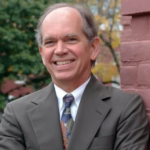

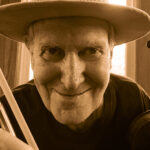
Thank you so much for this. This is what journalism is all about. Wonderful story, beautifully written. Thank you.